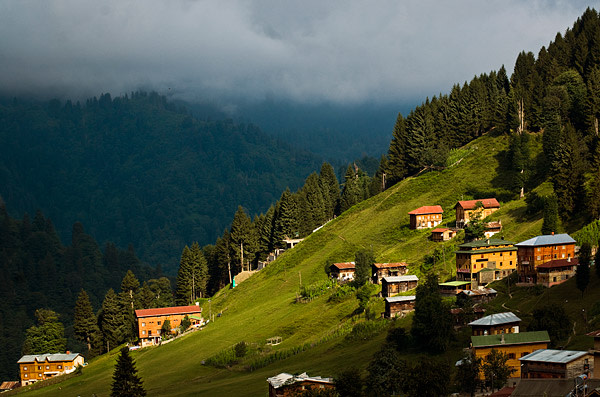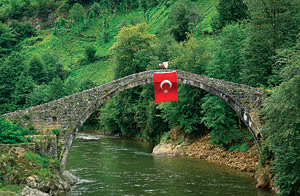Turkey: land of milk and honey

Simply sign up to the Life & Arts myFT Digest -- delivered directly to your inbox.
When I first hiked up the steep, winding main street in Ayder, I wished that I’d brought along a Tyrolean hat. I also wished that I was able to sing, for I yearned to cock my head back and yodel, just like the Von Trapp family in The Sound of Music. Ayder felt to me like the Alps, even though it sits in far eastern Turkey, in the Kaçkar mountains close to the Black Sea.
The grassy hills are vivid green. Cows low in the pastures. Puffy clouds crawl over distant crags and, meanwhile, a snappy tourism industry bustles away. Ayder’s many eco-lodges are trim and modern: lustrous confections of dark wood perched on absurd inclines. One afternoon I watched as two young staffers at my hotel used a hand-cranked “luggage gondola” to winch heavy suitcases uphill to the lobby. I wondered why they were not wearing lederhosen.
I’d come to Ayder to experience the life of a yayla – that is, one of about 3,000 Turkish mountain villages where nomadic herders traditionally moved with their animals during summer, subsisting by producing cheese, yoghurt and honey. For centuries, Turkey’s yaylas were all but inaccessible to travellers. But over the past two decades or so, as Turkey has boasted Europe’s fastest-growing economy, the herds of cattle grazing the yaylas have dwindled and the number of hotel rooms has proliferated. It’s now possible for travellers to spend the day learning the rudiments of cheese making, or to hike amid mountain wildflowers, before returning to the lodge for a decent glass of Cabernet Sauvignon.
Yaylas are scattered throughout eastern Turkey and the Turkish Mediterranean, but Ayder is perhaps the best launch point for explorers. It’s a sort of yayla theme park – nearly devoid of resident shepherds but burbling with nonstop holiday fun. On the summer evening I arrived, the air was thick with the wail of the tulum, essentially a Turkish bagpipe. Impromptu circles of folk dancers formed on a gravel lot. Vendors hunched over smoky grills selling roast corn, and everywhere small bright plastic balls bobbled about beneath the blue sky. Children played catch; babies rolled the balls through the grass. I saw middle-aged men absent-mindedly tossing balls underhand as they sipped tea.

The balls were on sale for about 70p at roadside stands. At first I couldn’t understand their appeal. But then it dawned on me that many of the tourists were middle-class Turks who had recently emigrated to cities. For them, Ayder was an idyll, a dream, a return to Turkey’s simpler past.
I sat down at a café and watched the balls, weighing them against recent grave news stories about the Gezi Park protests and the Turks’ border skirmishes with Syria. It was lovely to see the Muslim world at leisure, in a soft light.
Later, I spotted two old women in headscarves – grandmothers, I presumed – standing on a grassy hill, swinging a baby inside a blanket. They were singing a lullaby.
There are about two dozen yaylas folded into the infinite green ravines within two hours’ drive of Ayder, and each valley is a distinct pastoral world. There are ethnic Greeks and Georgians herding cattle and sheep, each in their own separate valleys, speaking in their native language. One valley is home to the Laz people, fair-skinned long-ago émigrés from the Caucasus of Russia who even today speak Laz at home. They live in cliffside houses, high up on stilts, from which they used to watch for their enemies.
My guide for exploring the area was Adnan Pirikoglu, a genial 47-year-old beekeeper whose ancestors – the Hemshin people, from Uzbekistan and Tajikistan (or Armenia, depending on which theory you favour) – have been grazing cattle and goats for nearly a millennium. We arranged to meet at a street corner in Ayder, and he arrived in some pain. “It is mating season,” he said, “and we are moving the queen bees and they are stinging. I have six or eight stings on my head, and stings on my hands and also here,” he added, pointing lower, “in the pantalones.”
As we boarded a dolmusch, or public minivan, for Kavron, a small Hemshin yayla 14km up a rocky, winding dirt road, Pirikoglu explained that the bee stings were worth it as Turkish honey was like no other. In the Kaçkar Mountains alone, there are more than 150 endemic plant species, meaning that after bees draw pollen, they make exquisitely thick and complex organic honey. Kaçkar honey is among the world’s most expensive, selling for up to $100 a litre; it’s even said to heal ulcers and erectile dysfunction. The white rhododendron bushes near Ayder, meanwhile, can sometimes yield “crazy honey”. “One day I eat 150g of crazy honey,” Pirikoglu said. “I feel energy. I feel happy in my head. I am singing.”

Naturally, I proposed that Pirikoglu and I should try some crazy honey.
“No, dangerous!” he said, before explaining with a history lesson. In the fifth century BC, a legion of Greek soldiers gorged on crazy honey as they wandered towards the Black Sea. As the Greek general Xenophon would later describe it, his soldiers “lost their senses and were seized with a vomiting and purging, none of them being able to stand on their legs.”
I settled instead for seeing Kavron, elevation 2,300 metres. The dolmusch dropped us off in a green meadow, and Pirikoglu grew nostalgic smelling the grass. “Oh, the milk here smells like flowers,” he said. “And the potatoes are wonderful, so thin, so sweet.” We came upon some crude corrugated metal hovels, largely abandoned, and Pirikoglu was wistful. “Thirty years ago, you’d have 20 kids following you here – they want sugar, they want chocolate. Now, nobody.”
The newer houses were uphill, in upper Kavron, and occupied mainly by Pirikoglu’s wizened older relatives, many now retired from jobs in the cities. They sat on their clean-swept porches, squinting into the sun. Conversational highlight? “Dogan, where are your cows?”

The most beloved cows were underneath the houses, kept close like pets and wearing colourful nazarliks, beaded headbands that Muslim farmers believe can ward off bad luck.
Pirikoglu’s cousin, Havva Jazici, a shy woman in her fifties, taught me how to turn milk into butter by using a rock as a kitchen implement. Long story (don’t think any old rock will suffice) but by the time she finished, I’d learnt about muglama, a blend of cheese, cornflour and butter that, according to Hemshin legend, conveys superhuman strength.
When Pirikoglu and I repaired to Kavron’s general store/restaurant, I ordered a bowl – a move that won me some brownie points. “Mu-gla-ma!” Pirikoglu proclaimed, laughing and hammily flexing his biceps.
I needed the fortification. After our early supper, as Pirikoglu went back to his bees, I scrambled up the nearest mountain. I followed a trickling creek lined with purple wildflowers. I skirted patches of snow and pulled myself up over rocks for an hour until I was looking down at the clouds. They floated along slowly, in white, pillowy quilts, and every so often there was a gap through which I could see the tiny houses of Kavron.

Earlier, on a tour through a Laz village, my guide had told me how much the yaylas had changed. “When my father was young,” said Osman Albardarak, 35, “they got their first factory-made shoes but they were so bad they had to take them off to walk on bad roads, so they wouldn’t fall apart.” Now Albardarak has a Facebook page; in the profile picture he wears a Native American headdress – a reference to his favourite film, Dances with Wolves. He worries that change is coming too fast and opposes plans for a tourist road to the Laz’s highest summer camping grounds.
What I will remember most about my yayla adventure is not the thread count on the sheets at the delightful eco-lodge in Ayder, but the rougher splendours – such as the sight, far below, of someone in Kavron bearing a shepherd’s staff as he trailed his cows.
I climbed down eventually to an outdoor café in Kavron, and sat there in the evening chill beside some village locals. We had very little common language, these old men and I, but we had enough. “Güzel,” we kept repeating, in Turkish, as night fell and stars appeared in the dark sky. “Beautiful, beautiful.”
——————————————-
Details
Bill Donahue was a guest of the Oberj hotel in Ayder which offers three nights from £135. Pegasus Airlines flies direct from Istanbul to Trabzon, 110km from Ayder. See also www.goturkey.com
Comments